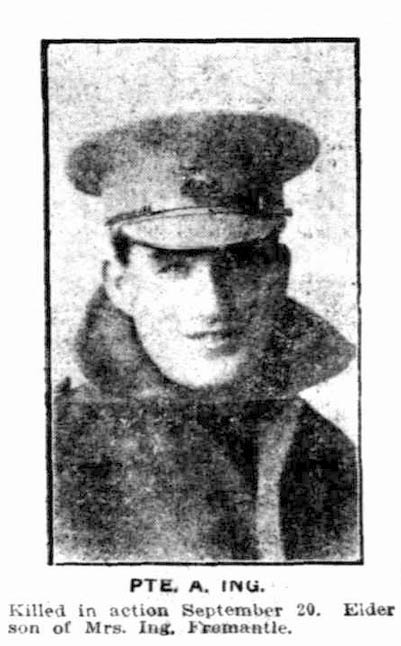Pte
Arthur Harry Ing
Informatie over geboorte
|
Geboortejaar: 1887 |
|
Geboorteplaats: Manor Park, Essex, Engeland, Verenigd Koninkrijk |
Algemene Informatie
|
Beroep: Winkelier |
Informatie legerdienst
|
Land: Australië |
|
Strijdmacht: Australian Imperial Force |
|
Rang: Private |
|
Service nummer: 6335 |
|
Dienstneming datum: 01/09/1916 |
|
Dienstneming plaats: Fremantle, Western Australia, Australië |
|
Eenheden: — Australian Infantry, 28th Bn. (Western Australia) (Laatst gekende eenheid) |
Informatie over overlijden
|
Datum van overlijden: 20/09/1917 |
|
Plaats van overlijden: Anzac, Zonnebeke, België |
|
Doodsoorzaak: Killed in action (K.I.A.) |
|
Leeftijd: 30 |
Begraafplaats
|
Buttes New British Cemetery, Polygon Wood Plot: XXVI Rij: A Graf: 16 |
Onderscheidingen en medailles 2
|
British War Medal Medaille |
|
Victory Medal Medaille |
Points of interest 3
| #1 | Geboorteplaats | ||
| #2 | Dienstneming plaats | ||
| #3 | Plaats van overlijden (bij benadering) |
Mijn verhaal
Private Arthur Harry Ing served in the 28th Battalion Australian Infantry, part of the 7th Australian Brigade, of the 2nd Australian Division. His Division participated in the Battle of Menin Road on the 20th of September 1917. This Battle was a phase of the Third Battle of Ypres. The 2nd Division attacked Anzac Ridge with two Brigades, the 7th Australian Brigade on the right and the 5th Australian Brigade on the left. Its jump off line was just east of the hamlet of Westhoek. The attack of the 7th brigade was carried by the 25th Battalion; the 27th Battalion was in support and the 28th Battalion in reserve. Each was responsible for capturing an objective.
At 5.40 a.m. an intense barrage was put down and the first attacking Battalions of the Division advanced behind the creeping barrage. The 28th Battalion, in reserve remained at the jumping off positions, suffering only slight casualties due to a German barrage. At 8 a.m. it was reported that the 1st and 2nd objectives had been captured. Ten minutes later the Battalion advanced to take up positions at the 2nd objective in anticipation of capturing the 3rd objective. The going was hard, but the Battalion suffered only slight casualties.
At 10 a.m. the 28th Battalion attacked through Albania Woods. They didn’t encounter much resistance. The Woods were littered with large numbers of German defenders in the woods, who had been killed by the barrage or by rifle fire. Moments later the 28th Battalion had captured its objective and started consolidating a line, roughly running from the northern outskirts of Albania Woods to Polygon Wood.
The Germans periodically shelled the support area and frontline throughout the afternoon. At 7 p.m. the Company on the right was threatened by a German counterattack from Polygon Wood. But the attack was checked, with the help of an artillery barrage. While the attack had been stopped, the German artillery shelled the battalion’s frontline for over an hour. Until the shelling finally stopped round 10 p.m. All remained relatively quiet till the Battalion was eventually relieved sometime past midnight.
Private Arthur Harry Ing was killed in action on the 20th of September 1917, during the Battle of Menin Road. He was initially buried in the field just south of Anzac House, on the Anzac Ridge. He was possibly killed while the 28th Battalion was advancing to the 2nd objective. His remains were exhumed after the war and were interred in Buttes New British Cemetery.
At 5.40 a.m. an intense barrage was put down and the first attacking Battalions of the Division advanced behind the creeping barrage. The 28th Battalion, in reserve remained at the jumping off positions, suffering only slight casualties due to a German barrage. At 8 a.m. it was reported that the 1st and 2nd objectives had been captured. Ten minutes later the Battalion advanced to take up positions at the 2nd objective in anticipation of capturing the 3rd objective. The going was hard, but the Battalion suffered only slight casualties.
At 10 a.m. the 28th Battalion attacked through Albania Woods. They didn’t encounter much resistance. The Woods were littered with large numbers of German defenders in the woods, who had been killed by the barrage or by rifle fire. Moments later the 28th Battalion had captured its objective and started consolidating a line, roughly running from the northern outskirts of Albania Woods to Polygon Wood.
The Germans periodically shelled the support area and frontline throughout the afternoon. At 7 p.m. the Company on the right was threatened by a German counterattack from Polygon Wood. But the attack was checked, with the help of an artillery barrage. While the attack had been stopped, the German artillery shelled the battalion’s frontline for over an hour. Until the shelling finally stopped round 10 p.m. All remained relatively quiet till the Battalion was eventually relieved sometime past midnight.
Private Arthur Harry Ing was killed in action on the 20th of September 1917, during the Battle of Menin Road. He was initially buried in the field just south of Anzac House, on the Anzac Ridge. He was possibly killed while the 28th Battalion was advancing to the 2nd objective. His remains were exhumed after the war and were interred in Buttes New British Cemetery.
Bronnen 4
|
28th Australian Infantry Battalion, (Australian War Memorial, Campbell (AWM), AWM4 23/45/30). https://www.awm.gov.au/collection/C1338583 Gebruikte bronnen |
|
Australian War Memorial https://www.awm.gov.au/ Gebruikte bronnen |
|
First Australian Imperial Force Personnel Dossiers, 1914-1920, (National Archives of Australia, Canberra (NAA), B2455, ING A H). http://recordsearch.naa.gov.au/SearchNRetrieve/Interface/SearchScreens/BasicSearch.aspx Gebruikte bronnen |
|
McCarthy C., The Third Ypres Passchendaele. The Day-by-Day Account, (London, Arms & Armour Press, 1995), pg. 72-75. Gebruikte bronnen |
Meer informatie 4
|
Namenlijst (In Flanders Fields Museum) https://namenlijst.org/publicsearch/#/person/_id=dec3146b-2e60-43c3-8ed7-7d15b18b3515 |
|
Lives of the First World War (Imperial War Museum) https://livesofthefirstworldwar.iwm.org.uk/lifestory/7495738 |
|
The AIF Project (UNSW Canberra) https://aif.adfa.edu.au/showPerson?pid=149204 |
|
Commonwealth War Graves Commission Database https://www.cwgc.org/find-records/find-war-dead/casualty-details/480296 |
